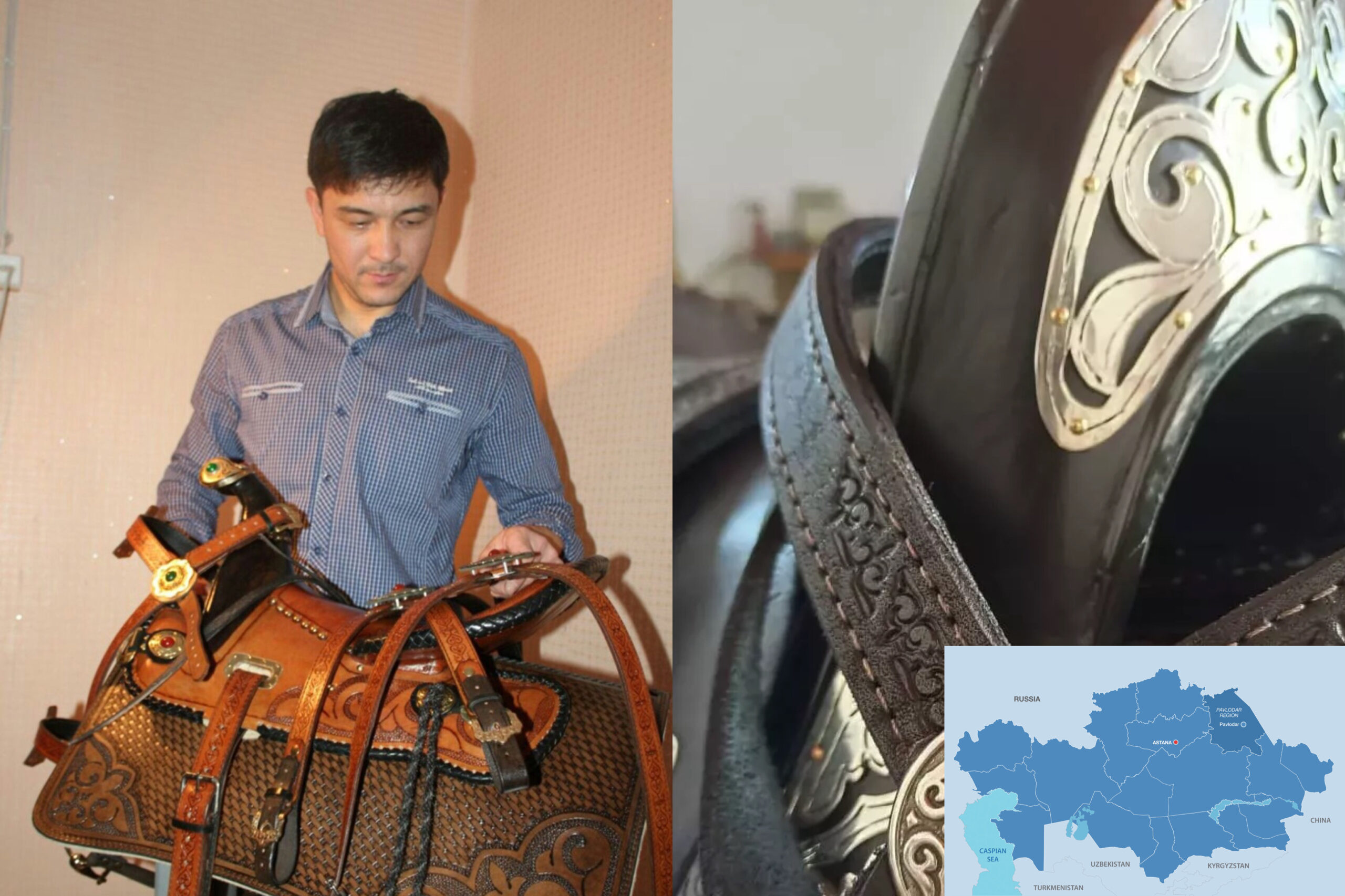The Astana Times provides news and information from Kazakhstan and around the world.ASTANA – Kazakh craftsman Yerzhigit Toktaruly has spent over 20 years mastering the traditional Kazakh craft of saddle-making, working from his home in the Pavlodar Region.Kazakh craftsman Yerzhigit Toktaruly.
Photo credit: artandcrafts.cultural.kz Click to see the map in full size.

The map is designed by The Astana Times.Toktaruly shares his creations on TikTok, where he has around 10,000 followers. He also shares step-by-step masterclasses, demonstrating how to make equestrian gear from start to finish.
He welcomes young artisans to learn from his videos and encourages them to try the craft themselves.For the past decade, Toktaruly has revived ancestral traditions by adapting them to the modern era, turning his passion into a source of income. Besides saddles and horse tack, he crafts dombras, leather tableware, home decor, and traditional women’s jewelry, many of which are now in private collections.
On his TikTok account, Toktaruly shares not only his creations but also step-by-step masterclasses. Photo credit: Toktaruly’s TikTok pageBut it is the saddle that remains closest to his heart.“Most people know me as a saddle maker.
My creations — saddles, bridles, and other equipment — can be found across nearly every region of Kazakhstan. Sometimes they are gifted to foreign dignitaries or displayed at international exhibitions,” said Toktaruly in an interview with Kazinform. According to him, historically, Kazakhs used 35 types of saddles, many of which are no longer in use.
Their key advantage, he said, is comfort, an essential feature for Kazakh ancestors who spent most of their lives on horseback.“For example, the uisin er, common in central Kazakhstan, is ideal for long-distance riding and games like kokpar. Its front arch is perfect for tying ropes or gear.
Other types include kusmoiyn, argyn, kerei, and naiman [the names are derived from Kazakh tribal names]. The argyn and naiman saddles are similar, though the naiman is slightly larger. These were considered military saddles — the high front helped protect the rider from arrows,” he said.
He also makes saddles specifically for berkutchi, also known as eagle hunters. One recent project involves a saddle designed to carry a hunting falcon.Toktaruly explained that the saddle’s frame consists of five main parts: the front, back, two side panels, and the seat.
Some craftspeople use a single piece of wood, while others assemble multiple parts. Toktaruly often uses thick bullhide — 3.5 to 4 millimeters — for the sides, and lighter leather for the seat and spine.
He sources leather from Kazakhstan and Belarus, though he noted that higher-quality leather from Türkiye is available at a premium.“Ranchers and horseback riding enthusiasts today often request ‘field saddles,’ which have a lower front arch than traditional Kazakh designs,” he said.Photo credit: Toktaruly’s TikTok pageTo craft a frame, Toktaruly typically uses poplar wood.
He sometimes sources it himself or works with local woodworkers. His knowledge of multiple crafts has been passed down through generations — his grandfather was a blacksmith on a collective farm, and his father was a woodworker.“One of my most memorable projects was creating a saddle for the 220th anniversary of Abai’s father.
It was commissioned by patrons and later donated to a museum,” he said. He also crafted a decorative saddle for the 330th anniversary of Kabanbai Batyr for the Kyzylorda Region.It takes Toktaruly between one and one-and-a-half months on average to complete a single saddle, which he customizes to client specifications.
His prices range from 800,000 tenge (US$1,530) to 2.5 million tenge (US$4,780), though some master-made saddles in Kazakhstan can be sold for up to eight million tenge ($15,300).“My main clients are from the southern regions.
I put everything I know into each piece — from treating and carving leather to applying decorative ornaments and upholstering the seat. It’s all about balance and harmony,” he said.Toktaruly follows market trends closely and maintains connections with peers in the horse-breeding industry.
He has noticed increasing demand for sport bridles in recent years, which should meet international standards – lightweight, thin, and fitted with hollow metal bits to reduce weight.He customizes each bridle with Kazakh ornaments that enhance the horse’s elegance without overpowering it.“Saddle-making requires not just skill, but patience.
If even one part does not turn out right, I have to redo everything. It’s a time-consuming craft, and without inspiration, the final result will not shine. Many start with enthusiasm but give up halfway,” Toktaruly said.
“I see foreign craftspeople using machines for even the smallest details. I think technology will soon make its way into saddle-making, too. The key is to blend tradition with innovation,” he added.
The post Kazakh Saddle Maker Revives Centuries-Old Craft for New Generation appeared first on The Astana Times..
Entertainment

Kazakh Saddle Maker Revives Centuries-Old Craft for New Generation

The Astana Times provides news and information from Kazakhstan and around the world.ASTANA – Kazakh craftsman Yerzhigit Toktaruly has spent over 20 years mastering the traditional Kazakh craft of saddle-making, working from his home in the Pavlodar Region. Toktaruly shares his creations on TikTok, where he has around 10,000 followers. He also shares step-by-step masterclasses, demonstrating how to make equestrian gear from start to finish. He welcomes...The post Kazakh Saddle Maker Revives Centuries-Old Craft for New Generation appeared first on The Astana Times.















